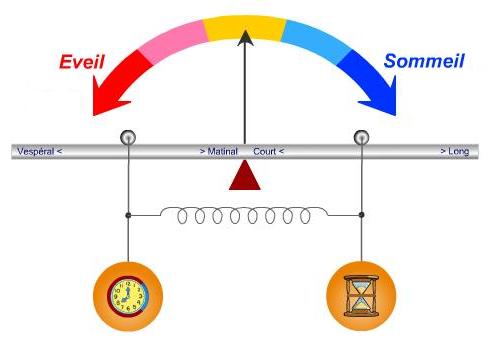Home > Welcome > Sleep-wake pathologies > Know how to sleep > Light therapy
"The sun is the watchmaker of the sleep mechanisms".
Light and the sleep-wake rhythm
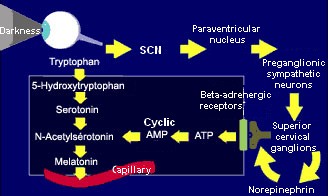
- Light and internal clock
Light is a part of the sleep synchronizers, based on the alternation between day and night.

It is the main «time giver» implicated when it comes to adapting to jetlag induced by transmeridian flights.
When the retina perceives light, it stops the secretion of a hormone called melatonin at the brain’s level.
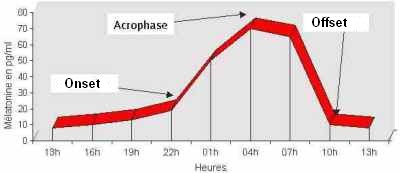
- Melatonin cycle
It seems as though the secretion rhythm of melatonin (during darkness) causes a drive of the temperature curve which coordinates the best period for sleep.
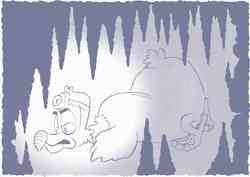
- From speleology to chronobiology
"Out of time" isolation experiments (which started in caves in the 70s) show that, in most subjects, the natural sleep-wake rhythm would be slightly higher than 24 hours if there was no effect of melatonin.
That explains that the shifts towards the West (which lengthen the "sun" day are compensated faster than the shifts towards the East).
During a shift of 6 hours towards the West, compensation occurs at the rhythm of more or less one hour per day, which means that it will take 6 days to synchronize sleep with the descending phase of the body temperature. And, when the traveller goes back (shorter hours of sunshine), his/her organism will take more time to "shorten" the cycle of the body temperature.
There exist a lot of individual variations in the field whether the subject is an evening or a morning person. Some subjects will even sometimes continue to "delay the clock" 14 more hours in order to compensate the shift just like a true trip around the world, heading towards the West.
It is known that the phase of the urinary cortisol can be disturbed more than 3 months after a three weeks journey from France to the West Indies.
The make-believes of oral melatonin ...
The use of synthetic melatonin (which can be found in the "organic" or parallel drugstores) is illusory.
The results of numerous clinical studies (in particular in airline pilots) are totally deceiving.
Oral melatonin is no longer a validated treatment of sleep disorders.
But a new class of medications is expected on the market in a close future, that of "melatonin agonists". They probably will be indicated in sleep disorders related to depressive states.
That kind of products might reveal very useful in the treatment of the "hypo-sleep syndrome".

Light therapy; light is a "somnication".
The effect of light exposure on the rhythm of melatonin and sleep is yet well proven by studies initiated in the Northern countries where the night lasts several months.
 More recently, the effect of phototherapy has been validated for the caretaking of sleep disorders described as "Season Affective Disease" where it has been shown that the shortening of the day’s duration in the winter induces mood disorders in some subjects.
More recently, the effect of phototherapy has been validated for the caretaking of sleep disorders described as "Season Affective Disease" where it has been shown that the shortening of the day’s duration in the winter induces mood disorders in some subjects.
A recent study of the ISV (Institute for Sleep and Vigilance) has shown that sleep duration is inversely proportional with the day’s duration (people sleep longer in the winter).
Prosom (an association which promotes knowledge about sleep, and works with the National Education since 30 years) asserts that the learning abilities are much higher during the summer than during the winter. (Jules Ferry, the minister who made school compulsory in France when 80% of it were rural, chose to let the children help with working in the fields during the summer months).

![]()
Practical applications...
These principles are successfully used in sleep disorders related to phase shifts and in preparing jetlag (in sportsmen and women for example).

The use of light in the infant’s or the child’s adaptation disorders is, in our opinion, of great interest.

An intense lighting is also very useful in the caretaking of dementias of Alzheimer type, which are situations where sleep disorders (with nocturnal agitation because of the upsetting of the nycthemeron) are very frequent.
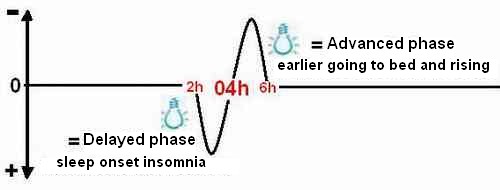
- Effect of light (and sport) on sleep rhythm "phase response curve"
The use of desktop lamps can favour the preparing of examinations (periods which are normally little propitious for sleep).
Uses of light therapy :
Numerous international studies agree with the therapeutic use of light in the following indications:
- Season affective disease (first choice treatment in the Northern countries);
- Juvenile depression (child, teenager);
- Seasonal bulimia;
- Post-partum depression (the well-known baby blues);
- Premenstrual depression;
NB: These new therapeutic possibilities must not contribute to consider too quicly that tiredness is a form of "masked" depression. It is normal to go through a true period of tiredness when one has to take care of a baby.
The definitions and limits of depression, described as "light to moderate" are based on criteria issued from a dichotomised conception of the illness, where disorders are either organic or psychological.
We defend the concept of somnosomatic diseases where a sleep disorder rooted in chronobiology would express through a chart of physical, psychological and social tiredness.
Yet the light represents a pragmatic and validated somnication of sleep disorders like : - The jet lag of the plane traveller;
- The (recently discovered) jet lag after general anaesthesia;
- The upsetting of the circadian rhythm in dementias of Alzheimer type;
- Sleep rhythm disorders (phase advance or delay) in the infant, the old person, the sick person;.
In an even more general manner, the broad use of light in houses and at work can only contribute to enhance the efficiency of sleep and, thus, the shape when getting up.
In France (but it is still not paid back by the Social Welfare System), phototherapy is used in the treatment of sleep phase disorders.
The effect of light is validated for a sufficient intensity (expressed in "Lumens"). It is considered that 2000 lux (or lumens) at the eyes’ level are necessary.
In practice, that requires the use of light sources of at least 10 000 lux (artificial light usually only develops from 300 to 700 lux). Outdoors lighting varies from 1500 lux in the winter to 100 000 lux in the summer, depending on the weather.
One or two hours of light exposure allow to act on the period of the cerebral clock with a "phase response" which gets inverted according to the moment of it. The advance or delay is highest when close to the thermal minimum (around 3 or 4 AM).

- Effect of light (and sport) on sleep rhythm "phase response curve"
- Thus, the subject can shorten his/her cycle by taking "light bathes" very early in the morning. That allows him/her to program his/her sleep earlier for the following evenings.
-In the same way, he/she can lengthen the period of the cycle by getting exposed to intense light during the evening and by filtering the light in the mornings (Cf "chromotherapy").
Photobiology research (the study of the biological effects of light) is about the mechanism of action of light in the treatment of winter depression.
The progress in understanding newly discovered systems of regulation (like the endocannabinoid system in the centre of it all) might come up with arguments for a larger use of light therapy.

These notions are a part of the sleep hygiene rules which have to be known for the caretaking of disorders linked to work in artificial light, shift or night work.
More generally, we think that light therapy is one of the essential somnications which have to be known in the context of chronic fatigue or fibromyalgia.

- Chromotherapy glasses
Research on the spectral control of light to favour the adaptation to night work has lead to the development of coloured glasses which, "when worn in the morning when getting back home after the night duty favour a better diurnal sleep of the worker".

(These glasses are available in France since a short while at agents of light therapy material).
In the opposite, the exposure to the light of a television or a computer screen late in the evening are suspected in some sleep onset insomnias.

Recent studies have shown that a (moderate) physical activity exerts an similar effect to light on the internal clock.
The two external "time givers" reciprocally enhance their effects.
It is easy to understand why late sorties in discotheques can carry along, for sensitive subjects (teenagers), a sleep onset delay (with trouble waking up) over several days.
An animation of the Double Pendulum of Sleep."

An example of chaotic movement that can be induced by brutal changes like jetlag or a sleep debt of a night worker. Designed by G. Tulloue (under Flashplayer 8).
The cursors can be moved to change the balance of the system. The Clock and the Hourglass.
The animation allows to understand the fragility of the balance and the parameters which have to be known to be able to act.
Ms Geneviève Tulloue is a physicist, keen of the "transversality of concepts". She willingly used her talent to bring the Double Pendulum of sleep to life. (We thank her heartily for her generous participation).
![]()

- More information...
- An information website for the promotion of light therapy.
- "Phototherapy prevention of troubles with adapting to night work", a very complete book (in French), downloadable for free (1123ko), (Boivin, Diane B.; James, Francine O); Montréal, IRSST, 2002, 108 pages) on the Canadian website "Security and health at work".
